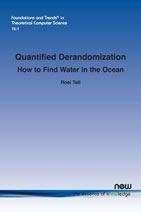Quantified Derandomization: How to Find Water in the Ocean
By Roei Tell, Institute for Advanced Study and DIMACS, USA, roeitell@gmail.com
Abstract
The focus of this survey is the question of quantified derandomization, which was introduced by Goldreich and Wigderson [44]: Does derandomization of probabilistic algorithms become easier if we only want to derandomize algorithms that err with extremely small probability? How small does this probability need to be in order for the problem’s complexity to be affected?
This question opens the door to studying natural relaxed versions of the derandomization problem, and allows us to construct algorithms that are more efficient than in the general case as well as to make gradual progress towards solving the general case. In the survey I describe the body of knowledge accumulated since the question’s introduction, focusing on the following directions and results:
1. Hardness vs “quantified” randomness: Assuming sufficiently strong circuit lower bounds, we can derandomize probabilistic algorithms that err extremely rarely while incurring essentially no time overhead. 2. For general probabilistic polynomial-time algorithms, improving on the brute-force algorithm for quantified derandomization implies breakthrough circuit lower bounds, and this statement holds for any given probability of error. 3. Unconditional algorithms for quantified derandomization of low-depth circuits and formulas, as well as near-matching reductions of the general derandomization problem to quantified derandomization for such models. 4. Arithmetic quantified derandomization, and in particular constructions of hitting-set generators for polynomials that vanish extremely rarely. 5. Limitations of certain black-box techniques in quantified derandomization, as well as a tight connection between black-box quantified derandomization and the classic notion of pseudoentropy.
Most of the results in the survey are from known works, but several results are either new or are strengthenings of known results. The survey also offers a host of concrete challenges and open questions surrounding quantified derandomization.
Quantified Derandomization: How to Find Water in the Ocean
The focus of this monograph is the question of quantified derandomization. Does derandomization of probabilistic algorithms become easier if we only want to derandomize algorithms that err with extremely small probability? How small does this probability need to be in order for the problem’s complexity to be affected?
In this comprehensive survey of the topic, the author describes the body of knowledge accumulated since the question was first raised in 2014, focusing on the following directions: 1) Hardness vs “quantified” randomness; 2) Improving on the brute-force algorithm for quantified derandomization implies breakthrough circuit lower bounds; 3) Unconditional algorithms for quantified derandomization of low-depth circuits and formulas; 4) Arithmetic quantified derandomization; 5) Limitations of certain black-box techniques and pseudoentropy.
Written for researchers, this monograph provides the readers with a concise overview of all known results, but the author also shows several results that are either new or are strengthenings of others. The author also offers a host of concrete challenges and open questions surrounding quantified derandomization.
